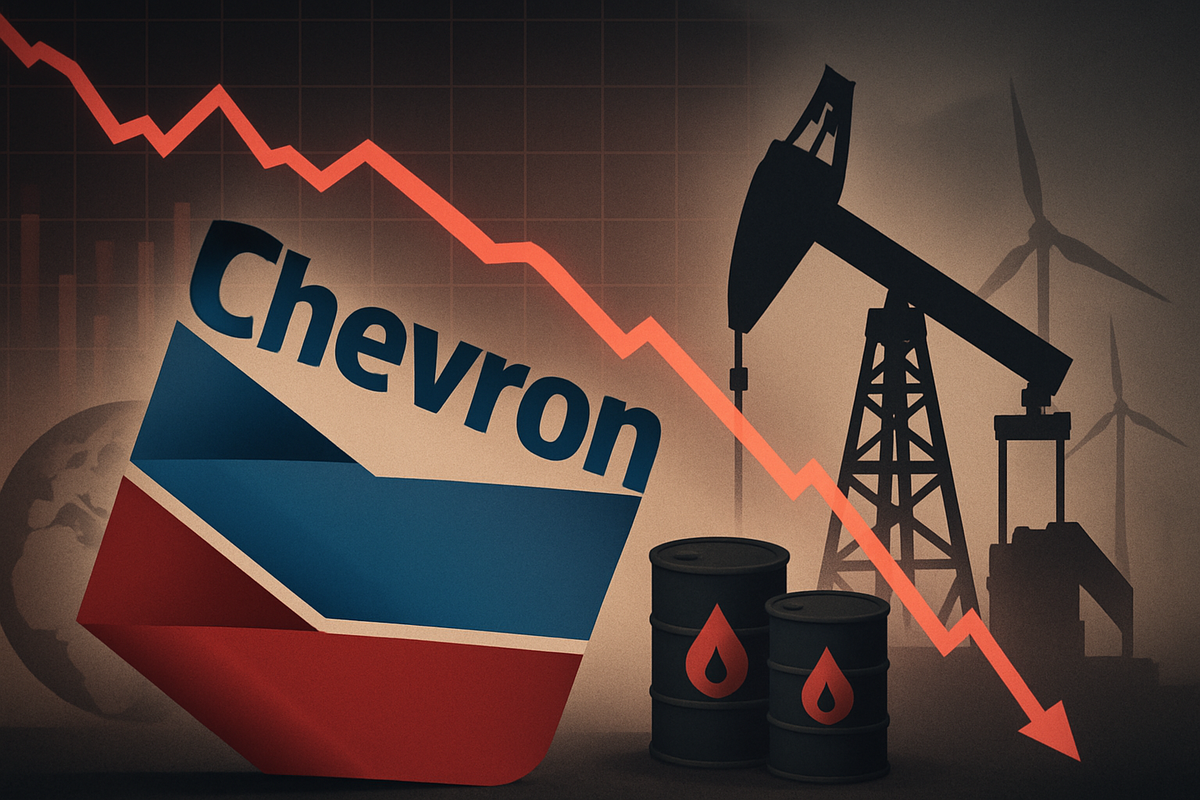
San Ramon, CA – October 13, 2025 – Chevron Corporation (NYSE: CVX), a titan in the global energy landscape, experienced a notable downturn today, with its stock price falling by nearly 2%. This significant movement positioned the integrated energy giant as a bottom performer in a broader market that saw energy stocks broadly decline. The drop comes as investors grapple with a confluence of factors, including fluctuating global oil prices, strategic acquisition costs, and evolving geopolitical stability in key oil-producing regions. This immediate dip raises questions about short-term market sentiment towards the energy sector, even as analysts maintain a long-term bullish outlook for Chevron.
The nearly 2% decline in Chevron's shares today reflects a complex interplay of market forces, signaling investor apprehension regarding the immediate future of crude oil and the profitability of upstream operations. For investors, Chevron remains a compelling watch, not just for its sheer size and dividend history, but for how it navigates these volatile currents, particularly with its strategic expansions and upcoming investor communications. The company's resilience and adaptive strategies in the face of such headwinds will be closely scrutinized as the market moves forward.
Unpacking Chevron's Slide: Geopolitical Shifts, Earnings Forecasts, and Operational Hurdles
Today's almost 2% fall in Chevron's stock can be attributed to several critical developments that collectively dampened investor enthusiasm. A significant contributing factor was the reported impact of a peace agreement in Gaza, which, according to market reports, sent oil prices lower due to diminished threats to OPEC supply. Such geopolitical resolutions, while positive on a humanitarian front, often lead to a re-evaluation of risk premiums in the oil markets, frequently resulting in price corrections.
Adding to the pressure, UBS Securities indicated an anticipated sequential decline in Chevron's Q3 earnings. The investment bank projected adjusted earnings per share to decrease to $1.65 from $1.77, largely due to costs associated with its substantial acquisition of Hess Corporation. While the Hess deal is strategically vital for Chevron's long-term growth, particularly in doubling its free cash flow by 2027 (assuming oil prices around $70 per barrel), the immediate integration costs are weighing on near-term financial performance. This news, coupled with the ongoing arbitration dispute with ExxonMobil (NYSE: XOM) over the Hess deal, adds an element of uncertainty that investors are closely monitoring.
Further compounding the narrative was institutional investor activity, with entities like the Oregon Public Employees Retirement Fund reportedly decreasing their positions in Chevron in the preceding quarter. While not directly tied to today's movement, such shifts by large funds can signal broader sentiment or contribute to downward pressure if they become public knowledge or part of a larger trend. Operationally, a fire at Chevron's El Segundo refinery, though reportedly extinguished with operational adjustments underway, served as a reminder of the inherent risks in the energy sector, potentially raising concerns about stability and unforeseen costs. These combined factors created a challenging environment for Chevron's stock performance on this particular day, contributing to its designation as a bottom performer within the energy sector.
Market Ripple Effects: Winners, Losers, and Sector-Wide Implications
The nearly 2% decline in Chevron's (NYSE: CVX) stock, driven by factors like falling oil prices and anticipated earnings pressures, sends ripple effects across the entire energy sector, creating potential winners and losers. Integrated oil and gas majors, whose business models are heavily reliant on crude oil prices, often move in tandem. Therefore, competitors like ExxonMobil (NYSE: XOM), Shell plc (NYSE: SHEL), and BP p.l.c. (NYSE: BP) are likely to face similar headwinds if the underlying causes—such as a sustained drop in oil prices—persist. A general decrease in oil prices can compress profit margins for these companies, particularly in their upstream (exploration and production) segments, which are highly sensitive to commodity price fluctuations.
Conversely, companies with a greater emphasis on downstream operations (refining and chemicals) might see some relief, as lower crude input costs can boost refining margins, assuming demand for refined products remains robust. However, most major players like Chevron have significant upstream exposure, making them vulnerable to such market shifts. Smaller independent exploration and production (E&P) companies, often with less diversified portfolios and higher operational leverage, could feel an even more acute pinch from sustained lower oil prices, potentially leading to increased consolidation activity in the sector.
Beyond direct competitors, industries that rely heavily on energy as an input cost could potentially benefit. Transportation sectors, including airlines like Delta Air Lines (NYSE: DAL) and United Airlines Holdings (NASDAQ: UAL), and logistics companies, might see reduced fuel expenses, translating into improved profitability or the ability to offer more competitive pricing. Similarly, manufacturing and industrial sectors with substantial energy consumption could experience a positive impact on their operating costs. However, the overall macroeconomic environment, including global demand and economic growth, remains a critical determinant of how these potential benefits translate into actual financial gains for these downstream and energy-consuming industries.
Broader Significance: Industry Trends, Regulatory Landscape, and Historical Context
Chevron's recent stock performance, particularly its decline amidst shifting oil prices and strategic acquisition costs, is not an isolated incident but rather a microcosm of broader trends shaping the global energy industry in late 2025. The sector is currently navigating a complex transition, balancing the ongoing demand for fossil fuels with increasing pressures for decarbonization and energy transition initiatives. Fluctuations in oil prices, often triggered by geopolitical events like the Gaza peace agreement, highlight the persistent volatility inherent in a market still heavily influenced by supply-demand dynamics and regional stability. This event underscores how quickly sentiment can shift, impacting the profitability and valuation of major players.
The Hess acquisition, a significant strategic move for Chevron, exemplifies the industry's drive for consolidation and securing long-term, high-quality assets, particularly in prolific basins like Guyana. Such large-scale M&A activities reflect a belief in the continued relevance of traditional energy sources for decades to come, even as companies simultaneously invest in lower-carbon solutions. However, the associated integration costs and potential arbitration disputes, as seen with ExxonMobil, also reveal the complexities and financial pressures involved in these mega-deals, which can temporarily weigh on earnings and investor confidence.
From a regulatory and policy perspective, the emphasis on energy security, particularly in Europe and Asia, continues to underpin demand for reliable energy supplies, including natural gas and oil. However, the long-term shadow of climate policy and environmental regulations looms large. While a peace agreement might temporarily lower oil prices, the broader trend towards renewable energy and carbon reduction targets will continue to influence investment decisions and operational strategies for companies like Chevron. Historically, the energy market has always been cyclical, with periods of boom and bust tied to global economic growth, technological advancements, and geopolitical stability. This current period, marked by both traditional market drivers and a nascent energy transition, presents a unique historical juncture, demanding agility and foresight from industry leaders.
What Comes Next: Navigating Volatility and Strategic Imperatives
Looking ahead, the short-term trajectory for Chevron (NYSE: CVX) and the broader energy sector will largely depend on the stability of global oil prices, the pace of global economic growth, and the resolution of company-specific strategic initiatives. In the immediate future, investors will be keenly awaiting Chevron's upcoming Analyst Day on November 12, 2025. This event is poised to be a pivotal moment, offering crucial updates on upstream volume growth, the anticipated synergies from the Hess acquisition, the company's capital expenditure outlook, and its plans for return on capital. Clear communication and positive projections on these fronts could help restore investor confidence and provide a clearer picture of the company's financial health and strategic direction.
In the long term, Chevron faces the dual challenge of maximizing returns from its traditional fossil fuel assets while strategically investing in and expanding its lower-carbon energy portfolio. The successful integration of Hess Corporation will be paramount, as it is expected to significantly boost Chevron's free cash flow by 2027. However, the ongoing arbitration with ExxonMobil regarding the Hess deal remains a critical factor, and its resolution will provide much-needed clarity on the full value and operational impact of the acquisition. Market opportunities may emerge from continued global demand for reliable energy, particularly in developing economies, and from technological advancements that reduce the carbon intensity of traditional operations.
Potential strategic pivots for Chevron could include further optimization of its existing portfolio, aggressive pursuit of carbon capture and storage (CCS) projects, and targeted investments in renewable energy and hydrogen. The company's ability to adapt to evolving environmental regulations and investor expectations regarding ESG (Environmental, Social, and Governance) factors will be crucial for sustained growth and attracting capital. Potential scenarios range from a continued period of oil price volatility, demanding operational efficiency and cost control, to a more stable environment where strategic investments in diversified energy sources begin to yield significant returns. Investors should monitor geopolitical developments, OPEC+ decisions, global economic indicators, and Chevron's execution of its strategic plan, especially post-Analyst Day, to gauge future performance.
Comprehensive Wrap-up: A Market in Flux
Today's nearly 2% dip in Chevron's (NYSE: CVX) stock serves as a potent reminder of the inherent volatility and multifaceted influences at play within the global energy markets. The confluence of a Gaza peace agreement impacting oil prices, anticipated Q3 earnings decline due to the Hess acquisition, and operational events like the El Segundo refinery fire, all contributed to its performance as a bottom performer. Key takeaways include the immediate sensitivity of energy stocks to geopolitical shifts, the financial implications of large-scale strategic acquisitions in the near term, and the ongoing scrutiny by institutional investors.
Moving forward, the market's assessment of Chevron will be heavily influenced by its ability to demonstrate robust execution of its strategic objectives, particularly the successful integration and value realization from the Hess acquisition. The upcoming Analyst Day on November 12, 2025, will be a critical juncture, offering insights into the company's future capital allocation, production growth, and synergy capture. While short-term headwinds may persist, the long-term narrative for Chevron remains compelling for many analysts, predicated on its strong asset base, dividend yield, and strategic positioning for future energy demand.
Investors should closely watch several key indicators in the coming months: the trajectory of global oil prices and demand, the resolution of the ExxonMobil arbitration, the specifics unveiled at Chevron's Analyst Day, and the broader macroeconomic environment. The energy sector is in a period of significant transformation, balancing traditional energy demands with the imperative for a cleaner future. Chevron's journey through this complex landscape will not only define its own future but also offer valuable insights into the broader evolution of the global energy market.
This content is intended for informational purposes only and is not financial advice





